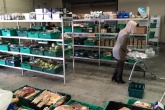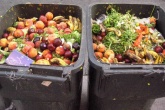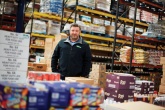Food labels to be made simpler to prolong product life and increase redistribution
Shoppers will be given a simpler, more consistent range of storage and date advice on food packaging after new WRAP guidance presented a new industry standard for date labelling and storage advice used by food manufacturers and retailers.

Two million tonnes of food are wasted every year in UK homes simply because it is not used in time, and research from WRAP suggests that a third of this is down to how shoppers interpret date labels currently used on packaging.
And while WRAP’s latest Retailer Survey found that changes to packaging and labelling had saved nearly 150,000 tonnes of food from being wasted in 2015, it also suggested that an additional 350,000 tonnes of avoidable household food waste, worth £1 billion, could be saved every year by addressing gaps in guidance on the freezing and refrigerating of products.
 Among the changes added to the new guidance is the simple addition of logos alongside text, which research suggests consumers find easier to understand than text on its own. It calls for the ‘Snowflake’ logo (suitable for freezing) to be reinstated where it may have been removed and also introduces a ‘Little Blue Fridge’ logo (right) for foods that would benefit from being kept in the fridge.
Among the changes added to the new guidance is the simple addition of logos alongside text, which research suggests consumers find easier to understand than text on its own. It calls for the ‘Snowflake’ logo (suitable for freezing) to be reinstated where it may have been removed and also introduces a ‘Little Blue Fridge’ logo (right) for foods that would benefit from being kept in the fridge.
As well as storage, WRAP found that four times as much food could be redistributed from retailer and manufacturers to feed people in need, and recommends that ‘Use By’ dates should only be used on foods that carry a risk of becoming unsafe in a short period of time.
It says that no other reason should warrant a ‘Use By’ date and that ‘Best Before’ dates should be increasingly used as foods can still be redistributed after this date has passed as long as it is fit to eat. The guidance also helps demonstrate that it’s perfectly legal to do so, which currently not all organisations are clear about.
This summer the Real Junk Food Project, a charity network that runs pay-as-you-feel cafes and supermarkets to facilitate redistribution, was threatened with prosecution by West Yorkshire Trading Standards after it found more than 400 items past their use-by-date in the charity’s warehouse.
The charity’s Founder Adam Smith told Resource at the time: “Given the nature of the kind of food that we were supplying, it would not have posed any risk to the public. If it was meat, fish and shellfish and it was off and past its use-by-date, then I could understand, but they didn’t find any produce like that, it was all perfectly sealed, low-risk items which we felt were mislabeled.”
WRAP working with businesses on implementation
Environment Minister, Thérèse Coffey said: “We know that confusing labels can contribute to food waste by suggesting that edible items need to be thrown away sooner than is necessary. This new guidance will make packaging much clearer for consumers, saving them money and reducing waste.
“I encourage all food businesses, large and small, to use this guidance to help them put the right date mark on food and help to guide people on the refrigeration and freezing of products which are crucial to reducing the amount of edible food thrown away.”
WRAP is now working with food companies and manufacturers to help implement changes across own-brand and branded items. Though it says that changes will take time to appear, it notes that some improvements have already been made.
More pasteurised fruit juices and hard cheeses have been moved from ‘Use By’ to “Best Before’ dates, more fresh produce is carrying advice to store it in the fridge, keeping it fresher for longer, and the use of ‘Freeze on the day of purchase’ labelling has been replaced by ‘Freeze before the date shown’, so that consumers do not think that by missing the first day the food is no longer safe.
“A key way to help reduce household food waste is to give people as long as possible to use the food they buy. Labelling information can help with many aspects of this,” said Marcus Gover, CEO at WRAP.
“Telling people clearly how long a product can be consumed once opened, and giving consistent and simple information about storing and freezing, will help people keep their food fresher for longer, and give more options to freeze the food and use it later- rather than binning food that could have been eaten. Now it’s time to implement these strategies and WRAP will continue to monitor how industry does.”
WRAP guidance on food date and storage labelling can be found on the WRAP website. 








